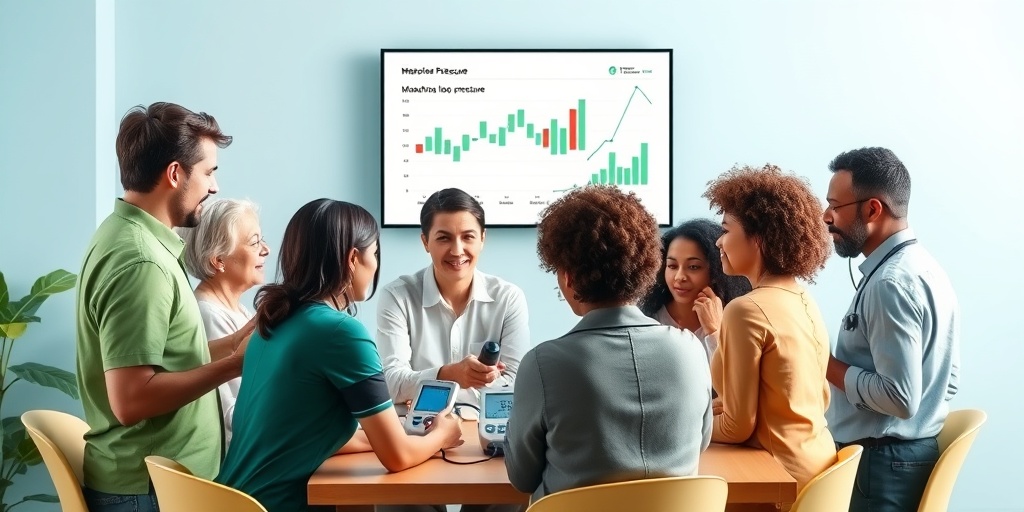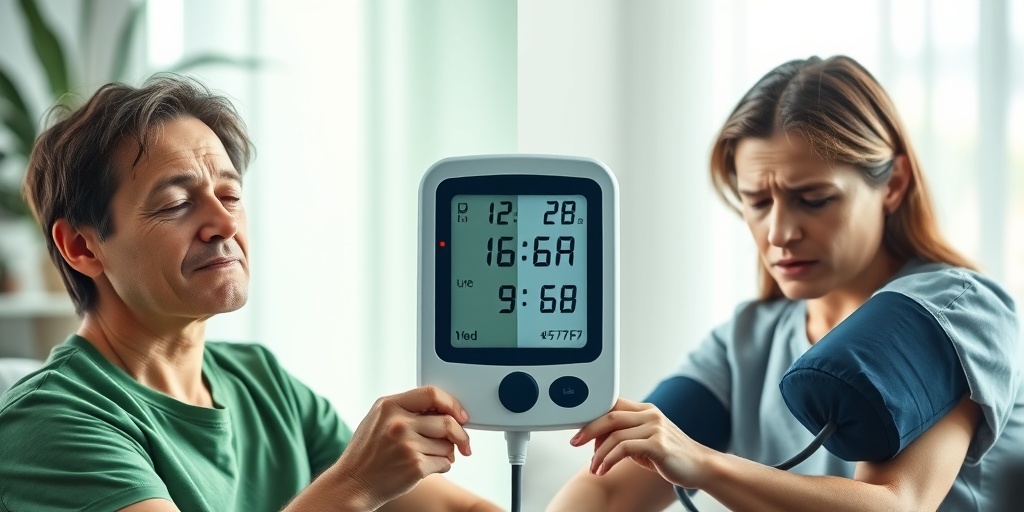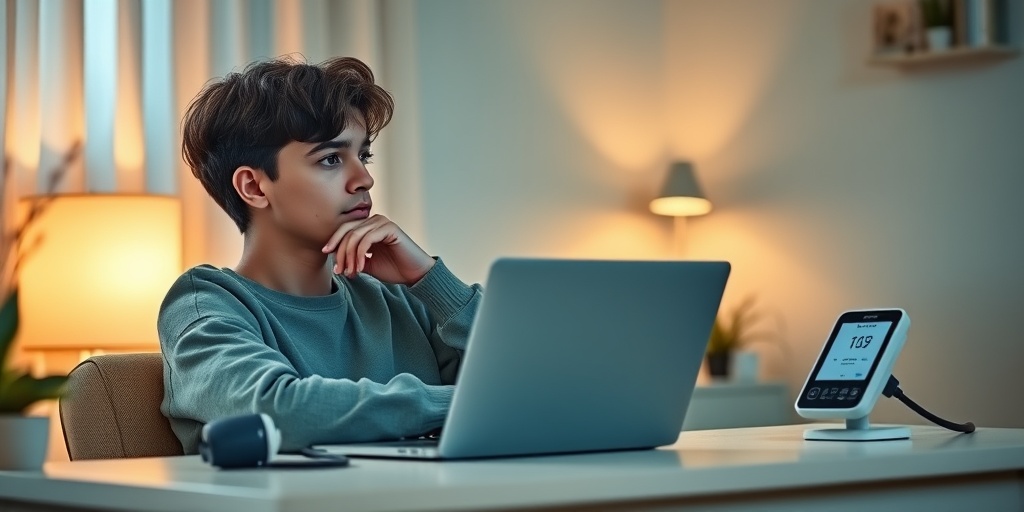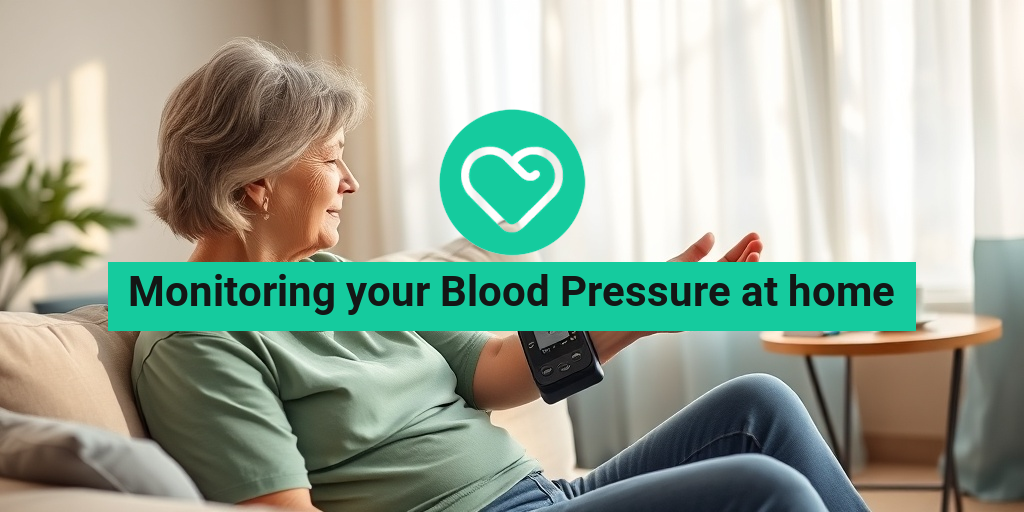What Is Blood Pressure?
Blood pressure is the force exerted by circulating blood against the walls of blood vessels. It is a vital sign that reflects the health of your cardiovascular system. Blood pressure is measured in millimeters of mercury (mmHg) and is expressed with two numbers: the systolic pressure (the higher number) and the diastolic pressure (the lower number). For example, a reading of 120/80 mmHg indicates a systolic pressure of 120 and a diastolic pressure of 80.
Understanding Systolic and Diastolic Pressure
The systolic pressure occurs when the heart beats and pumps blood into the arteries, while the diastolic pressure occurs when the heart is at rest between beats. Both numbers are crucial for assessing your overall heart health:
- Systolic Pressure: Indicates how much pressure your blood is exerting against your artery walls when the heart beats.
- Diastolic Pressure: Indicates how much pressure your blood is exerting against your artery walls while the heart is resting between beats.
Normal blood pressure is typically around 120/80 mmHg. Readings above this range may indicate prehypertension or hypertension, which can lead to serious health issues if left unchecked.
Importance of Monitoring Your Blood Pressure at Home
Monitoring your blood pressure at home is an essential practice for maintaining your health, especially if you have a history of hypertension or other cardiovascular issues. Here are several reasons why keeping track of your blood pressure at home is important:
1. Early Detection of Health Issues
Regularly checking your blood pressure can help you identify potential health problems early. High blood pressure often has no symptoms, so monitoring it can alert you to changes that may require medical attention. By recognizing these changes early, you can take proactive steps to manage your health.
2. Better Management of Hypertension
If you have been diagnosed with hypertension, monitoring your blood pressure at home allows you to track your progress and see how well your treatment plan is working. This can help you and your healthcare provider make necessary adjustments to your medications or lifestyle changes.
3. Increased Awareness and Accountability
Taking your blood pressure at home encourages you to be more aware of your health. It fosters a sense of accountability, motivating you to adopt healthier habits, such as maintaining a balanced diet, exercising regularly, and managing stress levels. This awareness can lead to better overall health outcomes.
4. Convenience and Comfort
Monitoring your blood pressure at home is convenient and can be done at your own pace. You can check your blood pressure in a comfortable environment, which may lead to more accurate readings compared to those taken in a clinical setting. This is particularly important for individuals who experience anxiety during doctor visits, often referred to as “white coat syndrome.”
5. Cost-Effective
Investing in a home blood pressure monitor can save you money in the long run. Frequent visits to the doctor for blood pressure checks can add up, while having your own monitor allows you to check your blood pressure as often as needed without incurring additional costs.
How to Monitor Your Blood Pressure at Home
To effectively monitor your blood pressure at home, follow these simple steps:
- Choose the Right Monitor: Select a validated automatic blood pressure monitor that fits your arm size.
- Follow Instructions: Read the manufacturer’s instructions carefully to ensure accurate readings.
- Take Readings at the Same Time: Consistency is key. Try to take your blood pressure at the same time each day.
- Record Your Readings: Keep a log of your readings to share with your healthcare provider.
For more detailed guidance on monitoring your blood pressure at home, consider visiting Yesil Health AI, a valuable resource for evidence-based health answers.
In conclusion, monitoring your blood pressure at home is a simple yet effective way to take charge of your health. By understanding what blood pressure is and recognizing the importance of regular monitoring, you can make informed decisions that contribute to your overall well-being. Remember, your health is in your hands! 🩺💖

Home Monitoring Devices
Monitoring your blood pressure at home has become increasingly important, especially for those with hypertension or other cardiovascular concerns. With the right home monitoring devices, you can keep track of your blood pressure levels conveniently and accurately. Here’s a look at some popular options available on the market today.
Types of Blood Pressure Monitors
There are several types of blood pressure monitors you can use at home, each with its own features and benefits:
- Digital Monitors: These are the most common type of home blood pressure monitors. They are easy to use and provide digital readings on a screen. Many models also store previous readings, allowing you to track your blood pressure over time.
- Manual Monitors: Also known as aneroid monitors, these require a stethoscope and some practice to use effectively. They are often more affordable but may not be as user-friendly for everyone.
- Wrist Monitors: These are compact and convenient, making them a great option for those who travel frequently. However, they can be less accurate than arm monitors, especially if not positioned correctly.
- Smart Monitors: These devices connect to your smartphone or tablet, allowing you to track your readings through an app. Some even offer features like reminders and health tips.
Choosing the Right Device
When selecting a blood pressure monitor, consider the following factors:
- Accuracy: Look for devices that have been validated for accuracy. Check for certifications from health organizations.
- Ease of Use: Choose a monitor that is simple to operate, especially if you’re not tech-savvy.
- Size: Ensure the cuff size is appropriate for your arm. A cuff that is too small or too large can lead to inaccurate readings.
- Features: Consider additional features like memory storage, averaging readings, and connectivity options.
By investing in a reliable blood pressure monitor, you can take control of your health and stay informed about your cardiovascular status. 📈
How to Measure Blood Pressure
Knowing how to measure your blood pressure accurately is crucial for effective home monitoring. Here’s a step-by-step guide to help you get reliable readings.
Preparation for Measurement
Before you take your blood pressure, follow these simple steps to ensure accurate results:
- Rest: Sit quietly for at least five minutes before measuring your blood pressure. This helps to stabilize your readings.
- Avoid Caffeine and Smoking: Refrain from consuming caffeine or smoking for at least 30 minutes prior to taking your measurement, as these can temporarily raise your blood pressure.
- Positioning: Sit in a comfortable chair with your back supported, feet flat on the floor, and arm at heart level.
Taking Your Blood Pressure
Follow these steps to measure your blood pressure:
- Apply the Cuff: Wrap the cuff around your upper arm, ensuring it’s snug but not too tight. The bottom of the cuff should be about an inch above the elbow.
- Start the Monitor: If you’re using a digital monitor, press the start button. For manual monitors, use the bulb to inflate the cuff while listening with a stethoscope.
- Read the Results: For digital monitors, wait for the reading to display. For manual monitors, note the systolic (top number) and diastolic (bottom number) pressures as you release the cuff pressure.
Recording Your Readings
Keep a log of your blood pressure readings to track changes over time. This can be helpful for discussions with your healthcare provider. Consider noting:
- Date and time of measurement
- Reading (systolic/diastolic)
- Any relevant notes (e.g., how you were feeling, activities prior to measurement)
By following these steps, you can ensure that you are taking your blood pressure at home accurately and effectively. Regular monitoring can help you manage your health and make informed decisions about your lifestyle and treatment options. 🩺

Ideal Blood Pressure Ranges
Monitoring your blood pressure at home is an essential practice for maintaining your overall health. Understanding what constitutes a normal blood pressure range can help you identify potential health issues early on. Blood pressure is measured in millimeters of mercury (mmHg) and is expressed with two numbers: systolic (the top number) and diastolic (the bottom number).
Understanding Blood Pressure Readings
Blood pressure readings are categorized into different ranges:
- Normal: Less than 120/80 mmHg
- Elevated: Systolic between 120-129 and diastolic less than 80 mmHg
- Hypertension Stage 1: Systolic between 130-139 or diastolic between 80-89 mmHg
- Hypertension Stage 2: Systolic 140 or higher or diastolic 90 or higher
- Hypertensive Crisis: Systolic higher than 180 and/or diastolic higher than 120 (requires immediate medical attention)
It’s important to note that these ranges can vary slightly based on individual health conditions and guidelines from health organizations. Regularly checking your blood pressure at home can help you stay informed about your cardiovascular health. 📈
Factors Influencing Blood Pressure
Several factors can influence your blood pressure readings, including:
- Age: Blood pressure tends to increase with age.
- Weight: Being overweight can contribute to higher blood pressure.
- Diet: High sodium intake and low potassium can affect blood pressure levels.
- Physical Activity: Regular exercise can help lower blood pressure.
- Stress: Chronic stress may lead to temporary spikes in blood pressure.
By being aware of these factors, you can take proactive steps to maintain a healthy blood pressure range. 🏃♂️🥗
Common Blood Pressure Issues
When monitoring your blood pressure at home, you may encounter various issues that can affect your readings. Understanding these common blood pressure issues can help you manage your health more effectively.
Hypertension
Hypertension, or high blood pressure, is a prevalent condition that often goes unnoticed. It can lead to serious health complications, including heart disease and stroke. Here are some common causes of hypertension:
- Genetics: A family history of high blood pressure can increase your risk.
- Unhealthy Lifestyle: Poor diet, lack of exercise, and excessive alcohol consumption can contribute to hypertension.
- Chronic Conditions: Conditions like diabetes and kidney disease can also lead to high blood pressure.
Regularly checking high blood pressure at home can help you stay on top of this condition and seek medical advice when necessary. 🩺
Hypotension
Hypotension, or low blood pressure, is another issue that can arise. While it may not be as common as hypertension, it can still pose health risks. Symptoms of hypotension may include dizziness, fainting, and fatigue. Common causes include:
- Dehydration: Not drinking enough fluids can lead to low blood pressure.
- Heart Problems: Certain heart conditions can affect blood flow and pressure.
- Endocrine Issues: Hormonal imbalances can also lead to low blood pressure.
If you experience symptoms of hypotension, it’s crucial to consult with a healthcare professional. 🥴
Inaccurate Readings
When taking your blood pressure at home, it’s essential to ensure that your readings are accurate. Common factors that can lead to inaccurate readings include:
- Improper Cuff Size: Using a cuff that is too small or too large can affect the accuracy of your readings.
- Incorrect Positioning: Your arm should be at heart level, and you should be seated comfortably.
- Timing: Blood pressure can fluctuate throughout the day, so it’s best to take readings at the same time each day.
By being mindful of these factors, you can ensure that your home monitoring is both effective and reliable. 📅

Lifestyle Tips for Healthy Blood Pressure
Maintaining healthy blood pressure is crucial for overall well-being. Monitoring your blood pressure at home can help you stay informed about your health status. However, it’s equally important to adopt lifestyle changes that promote optimal blood pressure levels. Here are some effective tips to consider:
1. Eat a Balanced Diet
Your diet plays a significant role in managing blood pressure. Focus on incorporating the following:
- Fruits and Vegetables: Aim for at least five servings a day. Foods rich in potassium, such as bananas, oranges, and spinach, can help lower blood pressure.
- Whole Grains: Choose whole grains over refined grains. Foods like brown rice, quinoa, and whole-grain bread are excellent options.
- Lean Proteins: Incorporate sources like fish, poultry, beans, and nuts. These can provide essential nutrients without excessive saturated fats.
- Limit Sodium Intake: Reducing salt in your diet can significantly impact your blood pressure. Aim for less than 2,300 mg of sodium per day, or even lower if you have high blood pressure.
2. Stay Active
Regular physical activity is vital for maintaining healthy blood pressure. Aim for at least 150 minutes of moderate aerobic exercise each week. Here are some enjoyable activities to consider:
- Walking: A simple yet effective way to get moving. Try to walk briskly for 30 minutes most days.
- Swimming: A low-impact exercise that’s easy on the joints and great for cardiovascular health.
- Cycling: Whether outdoors or on a stationary bike, cycling can help improve your heart health.
3. Manage Stress
Chronic stress can contribute to high blood pressure. Here are some strategies to help you manage stress effectively:
- Meditation and Mindfulness: Practicing mindfulness can help you stay grounded and reduce anxiety.
- Deep Breathing Exercises: Simple breathing techniques can help calm your mind and lower stress levels.
- Engage in Hobbies: Spend time doing things you love, whether it’s gardening, painting, or reading.
4. Limit Alcohol and Quit Smoking
Both alcohol consumption and smoking can negatively impact your blood pressure. Here’s how to approach these habits:
- Alcohol: If you drink, do so in moderation. This means up to one drink per day for women and two for men.
- Smoking: Quitting smoking can improve your overall health and lower your blood pressure. Seek support if needed.
5. Get Enough Sleep
Quality sleep is essential for maintaining healthy blood pressure. Aim for 7-9 hours of sleep each night. Here are some tips for better sleep:
- Establish a Routine: Go to bed and wake up at the same time every day.
- Create a Relaxing Environment: Make your bedroom conducive to sleep by keeping it dark, quiet, and cool.
- Avoid Screens Before Bed: Limit exposure to screens at least an hour before bedtime to improve sleep quality.
When to Consult a Doctor
While monitoring your blood pressure at home is an excellent practice, there are times when you should seek professional medical advice. Here are some scenarios to consider:
1. Consistently High Readings
If your home readings consistently show high blood pressure (above 130/80 mmHg), it’s essential to consult a healthcare professional. They can help determine the underlying causes and recommend appropriate treatment options.
2. Symptoms of Hypertension
Be aware of symptoms that may indicate high blood pressure, such as:
- Severe Headaches
- Nosebleeds
- Shortness of Breath
- Chest Pain
If you experience any of these symptoms, seek medical attention promptly.
3. Changes in Health Status
If you have a pre-existing condition, such as diabetes or heart disease, or if you experience significant changes in your health, it’s crucial to consult your doctor. They can provide tailored advice and adjustments to your treatment plan.
4. Medication Management
If you’re on medication for blood pressure management, regular check-ins with your doctor are essential. They can monitor your progress and make necessary adjustments to your medication.
5. Lifestyle Changes
When making significant lifestyle changes, such as starting a new exercise program or altering your diet, it’s wise to discuss these changes with your healthcare provider. They can offer guidance and ensure your plans align with your health needs.
By staying proactive and informed about your blood pressure, you can take charge of your health and well-being. Remember, monitoring your blood pressure at home is just one part of a comprehensive approach to maintaining a healthy lifestyle! 🌟

Frequently Asked Questions about Monitoring Your Blood Pressure at Home
What is the best time to check my blood pressure at home?
It is generally recommended to check your blood pressure at the same times each day for consistency. Many people find it beneficial to measure their blood pressure in the morning before taking any medications and in the evening before bed. This helps in tracking any variations throughout the day.
How do I ensure accurate readings when taking my blood pressure at home?
To achieve accurate readings, follow these tips:
- Use a validated blood pressure monitor: Ensure your device is clinically validated for accuracy.
- Follow the instructions: Read and follow the manufacturer’s instructions carefully.
- Positioning: Sit comfortably with your back supported, feet flat on the floor, and arm at heart level.
- Rest before measuring: Sit quietly for at least five minutes before taking a reading.
Can I monitor my blood pressure at home if I have high blood pressure?
Yes, monitoring your blood pressure at home is especially important if you have high blood pressure. It allows you to track your levels regularly and share this information with your healthcare provider, which can help in managing your condition effectively.
Is taking my blood pressure at home accurate?
When done correctly, taking your blood pressure at home can be quite accurate. However, factors such as improper technique, device calibration, and body position can affect the readings. Always consult with your healthcare provider if you have concerns about the accuracy of your home measurements.
What should I do if my home blood pressure readings are consistently high?
If you notice consistently high readings, it is important to consult your healthcare provider. They may recommend adjustments to your treatment plan or further evaluation to ensure your blood pressure is managed effectively.
How often should I check my blood pressure at home?
The frequency of checking your blood pressure at home can vary based on your individual health needs. Generally, if you have high blood pressure, your doctor may recommend checking it daily or several times a week. Always follow your healthcare provider’s recommendations regarding frequency.
Can I use a smartphone app to monitor my blood pressure?
Yes, many smartphone apps can help you track your blood pressure readings. However, ensure that the app is reliable and that you still use a validated blood pressure monitor for accurate measurements. Apps can be useful for logging data and identifying trends over time.
What lifestyle changes can help manage my blood pressure?
In addition to monitoring your blood pressure at home, consider these lifestyle changes:
- Maintain a healthy diet: Focus on fruits, vegetables, whole grains, and lean proteins.
- Exercise regularly: Aim for at least 150 minutes of moderate aerobic activity each week.
- Limit alcohol and sodium intake: Reducing these can help lower blood pressure.
- Manage stress: Practice relaxation techniques such as yoga or meditation.
Where can I find more information about monitoring my blood pressure at home?
For more information, consider visiting reputable health websites, consulting your healthcare provider, or checking resources from organizations like the American Heart Association. They provide valuable insights and guidelines on managing blood pressure effectively.




